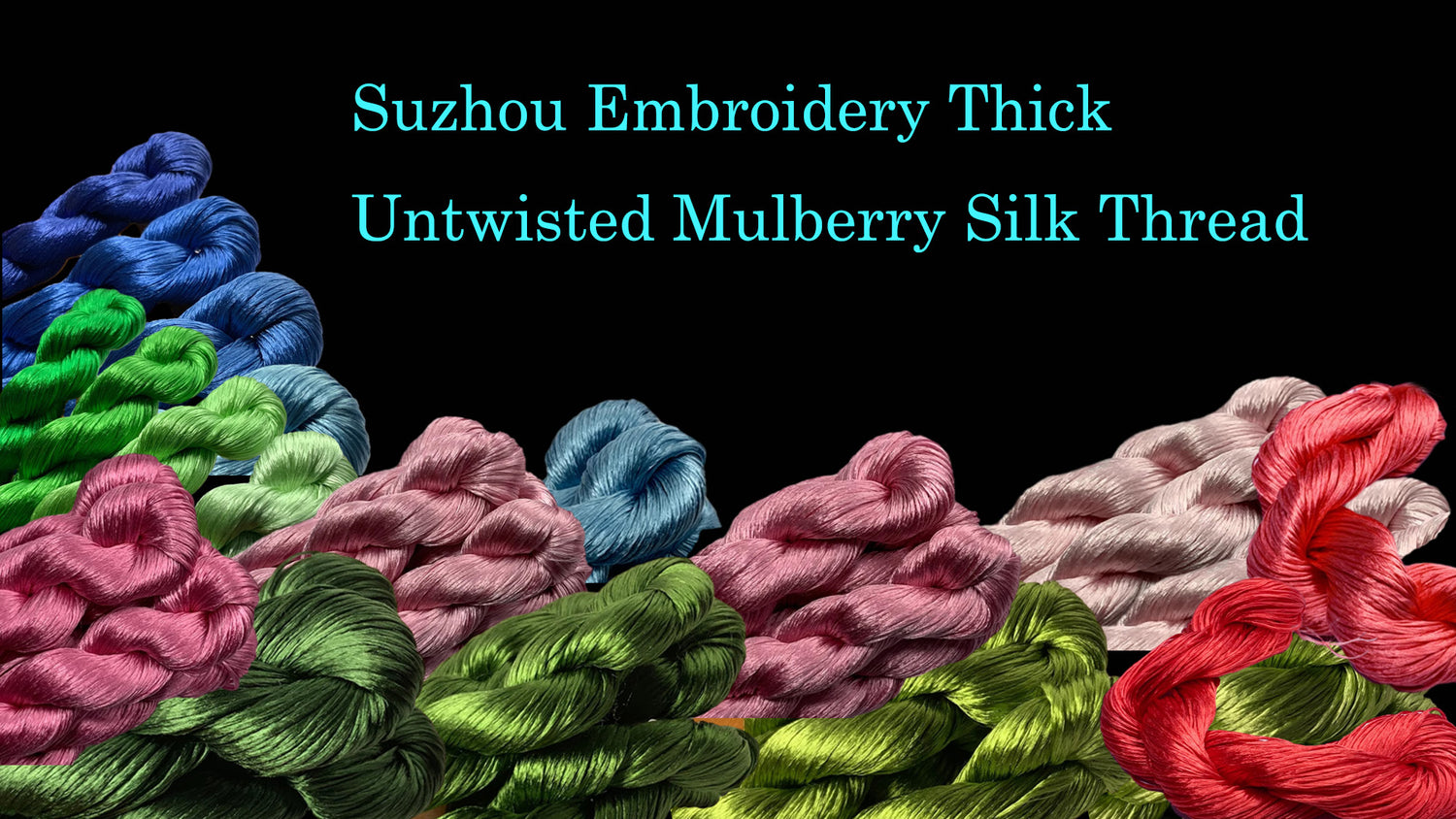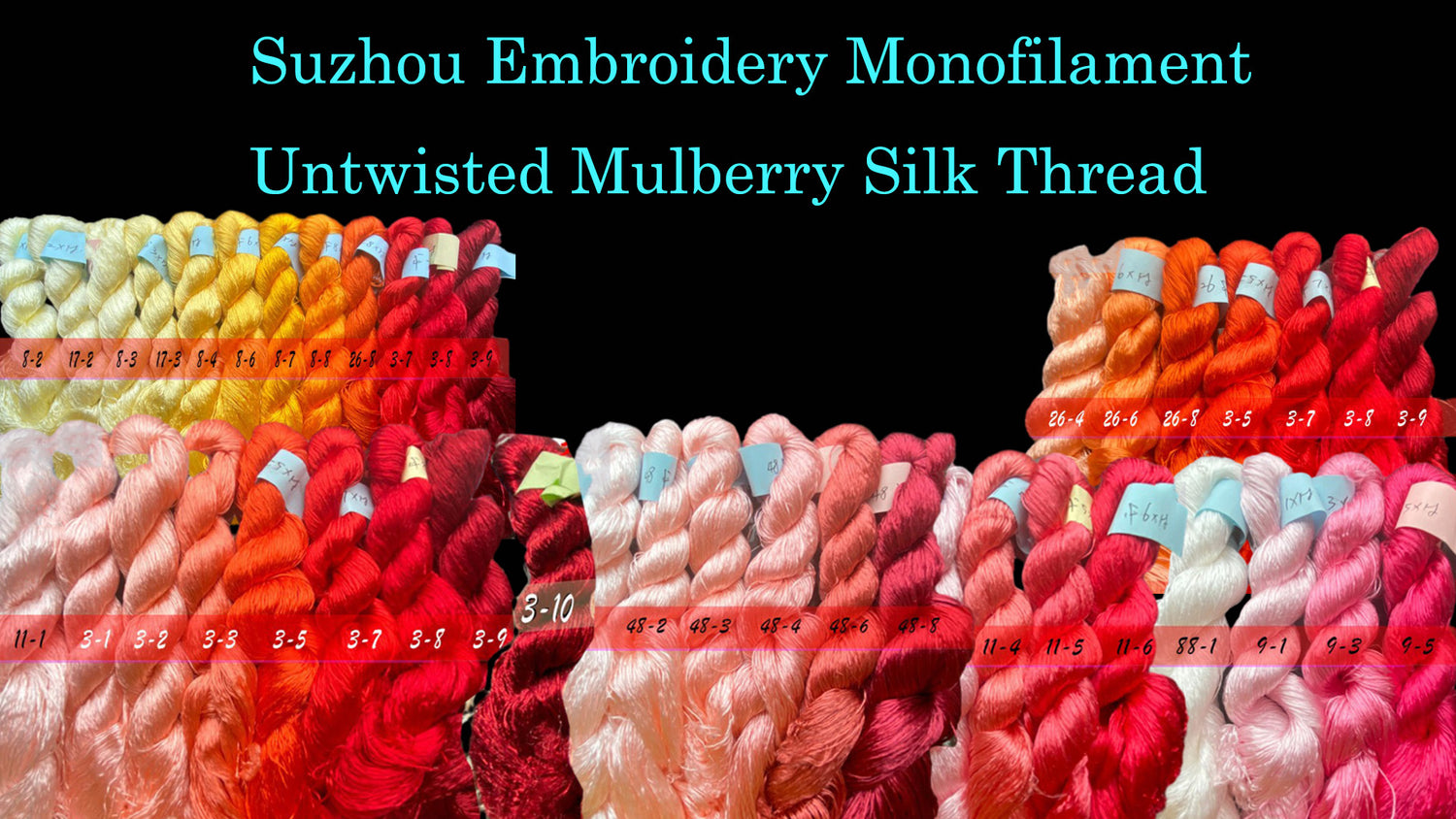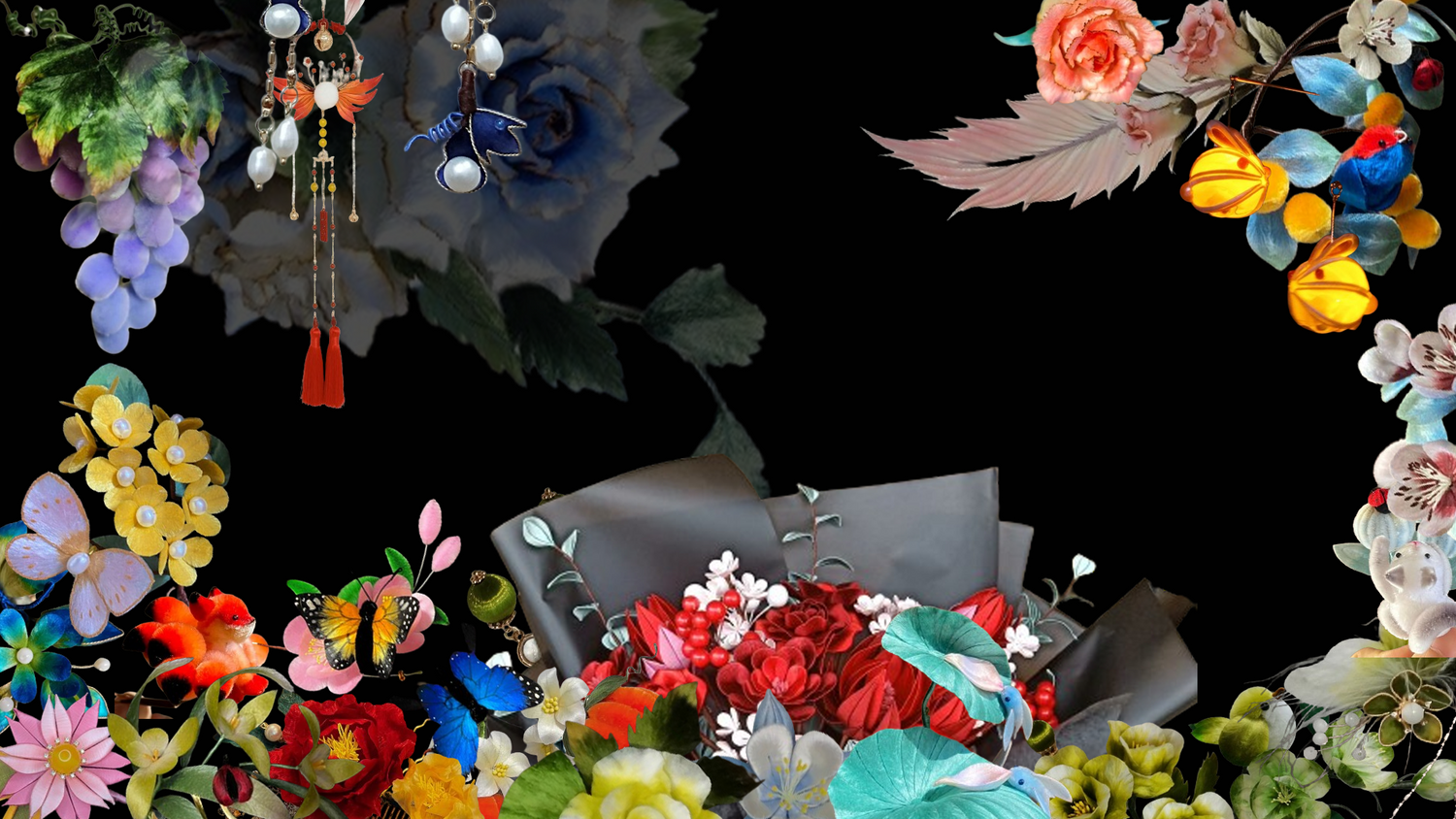
How to Make a Golden Pheasant Embroidery Fan - Handcraft Chanhua Tutorial
Share
The Golden Pheasant is a key decorative element in this embroidery piece and has a relatively complex structure. This section will introduce the methods for making each component of the Golden Pheasant and how to assemble them together.
A. Materials and Tools
- - White cardboard
- - Carbon pen
- - Scissors
- - 30 gauge mesh flower wire
- - Gold, pink, and red silk threads
- - Alcohol glue
B. Making the Beak (Upper and Lower Beak)
 1 2
1 2
1. Draw the shape of the upper beak on white cardboard with a carbon pen, and cut it out along the lines to obtain two paper patterns.
2. Hold the wire with your left hand, and wrap a pre-cut gold silk thread around it from left to right for about 1 cm, then wrap from right to left.
 3 4
3 4
3. Add the white cardboard pieces in sequence and wrap them to complete the upper beak.
4. Follow the same steps to wrap the two pieces for the lower beak.
 5 6
5 6
5. Combine the upper and lower beaks together, securing one end, bending the upper beak to match the length of the lower beak, and then securing the other end.
6. Bend the combined beak slightly from the center, separating the upper and lower parts a little.
C. Making the Head and Comb
 1
1
1. Draw 10 sets of feather patterns for the head on white cardboard, cut them out, and wrap them with a wire.
 2
2
2. Draw the comb pattern on white cardboard, cut it out, ensuring the comb is "S"-shaped with one end thick and the other end thin, starting to wrap from the thicker end.
 3
3
3. Fold the starting end of the wire to the back of the cardboard and clamp it tightly, then continue wrapping with silk thread, and secure it once done.
D. Making the Neck and Back
 1 2
1 2
1. Draw 10 sets of feather patterns for the neck on white cardboard, cut them out, and wrap them with a pink silk thread on a wire.
2. Draw 5 sets of feather patterns for Back 1 and Back 2 on white cardboard, cut them out, and wrap each set with red silk thread on two separate wires.
E. Making the Belly
 1
1
1. Draw one Belly 1, two Belly 2, and one Belly 3 patterns on white cardboard, and cut them out.
 2
2
2. Take a wire, add the cardboard, and wrap it with pink silk thread. Wrap perpendicular to the inner edge of the cardboard to leave enough space for the latter part of the wrapping.
 3 4
3 4
3. Once the entire cardboard is wrapped, secure it and cut off the excess thread. Use a pen to assist in shaping the belly feathers into a natural curve, then wrap the wire ends of the feathers together with silk thread.
4. Complete the wrapping of each belly feather as described in steps 2 and 3.
F. Making the Wings
 1
1
1. Draw feather patterns for the wings of the Golden Pheasant on white cardboard, including one set of short feathers and one set of long feathers, and cut them out for later use.
 2
2
2. Wrap each feather individually, wrapping from the tip inward. For the right wing, wrap from right to left; for the left wing, wrap from left to right.
 3 4
3 4
3. Combine the four long feathers first, then attach the short feathers to the base of the long feathers. Secure them with alcohol glue to prevent the feathers from shifting.
4. Complete the other wing using the same method.
G. Making the Tail
 1 2
1 2
1. Draw the tail component patterns 1-3 on white cardboard, with one piece of Component 1, four sets of eight pieces for Component 2, and four sets of eight pieces for Component 3. Cut them out along the lines and categorize them for easy access.
2. Wrap each of the three components separately, using gold silk thread for Component 1 and red silk thread for Components 2 and 3.
 3
3
3. Once all components are wrapped, stack and assemble them sequentially.
H. Assembly
 1
1
1. Adjust the shape of the head feathers and secure them with pink silk thread, ensuring six sets of feathers are on the top layer and four sets on the bottom layer. Use a pen to assist in bending the feathers towards the wire.
 2 3
2 3
2. Combine the beak and comb with the head and secure them with silk thread. The comb should be positioned directly above the beak.
3. Continue adding the neck to one side of the wire and secure it with silk thread.
 4
4
4. With the beak facing down and the comb facing up, add Belly 1 about 2.5 cm from the neck, facing down. After securing Belly 1, add the remaining belly components sequentially, spacing them about 7 mm apart, all facing downwards.
 5 6
5 6
5. Add Back 1 in front of Belly 1, ensuring Back 1 is snug against Belly 1. Secure it and then add Back 2 in front of Belly 3 using the same method.
6. Attach the wings to either side of Belly 2, ensuring not to mix up the left and right wings. Slightly bend the wings backward for a natural spread.
 7
7
7. Bend the feathers of the body parts (back, belly, and wings) backward, using a cylindrical tool to assist in maintaining a smooth and harmonious curve.
 8
8
8. Adjust the head of the Golden Pheasant similarly, paying attention to the direction of each part to ensure the head and body are as coordinated as possible.
 9
9
9. Attach the tail to the back of the Golden Pheasant and secure it with silk thread, with the tail feathers facing up.
 10
10
10. Wrap the excess wire from the tail assembly into branch-like shapes with gold silk thread, splitting the wire ends into two parts.
 11
11
11. Bend the wrapped wire backward, threading it through the central holes of Belly 2 and 3 from back to front, emerging just below the Golden Pheasant's body. Shape the wire ends into two legs and bend them to form the claws.
6.3.2 Making the Wintersweet
The wintersweet is one of the main elements in this embroidery piece, consisting of flowers and buds. This section will introduce the methods for making wintersweet flowers and buds, preparing for the overall assembly later.
A. Materials and Tools
- - White cardboard
- - Yellow silk threads
- - Carbon pen
- - 30 gauge mesh flower wire
- - Finished flower stamens
- - 6mm diameter glass pumpkin beads
- - Scissors
- - Chopsticks
B. Making the Wintersweet Flower
 1
1
1. Draw the pattern of the wintersweet petals on white cardboard with a carbon pen. The petals should be crescent-shaped and symmetrical. Cut them out along the lines.
 2 3
2 3
2. Take a silk thread and a wire, start wrapping, and then add the white cardboard. Pay attention to control the thread. When wrapping to the center of the cardboard, align the silk thread with the symmetry line of the cardboard.
3. Wrap the petals, then fold the wire ends of the petals together and secure them with silk thread. Use chopsticks to help shape the petals so that the inner side curves upwards.
 4 5
4 5
4. Take several finished flower stamens and tie them into a bundle with silk thread, making multiple bundles of stamens.
5. Following steps 1-3, make several petals and assemble them into a wintersweet flower, combining 3 or 5 petals together. Secure the stamen bundle in the center of the wintersweet flower.
 6
6
6. Take a wire and thread a 6mm diameter glass pumpkin bead onto it. Pass one end of the wire through the bead again and pull tight to secure the bead.
 7 8
7 8
7. Bend one end of the wire to fit snugly against the bead, then twist it around the other end of the wire, ensuring that the wire wrapping the bead is symmetrical with the previously threaded wire.
8. Following the steps above, make 6 wintersweet flowers with 5 petals, 8 wintersweet flowers with 3 petals, and 12 wintersweet buds, and group them for easy access.
6.3.3 Overall Assembly
After making each component, they need to be assembled in sequence. The wintersweet flowers and buds made in the previous section will be assembled during the making of the branches. This section will introduce the method for making the branches and the assembly of each component.
A. Materials and Tools
- - 30 gauge mesh flower wire
- - Brown-red silk threads
- - 1mm diameter wire
- - Cotton strips
- - Brown elastic thread
B. Making the Branches
 1 2
1 2
1. Take a wire about 25 cm long and start wrapping it from the middle.
2. While wrapping the wire, randomly add wintersweet flowers or buds.
 3 4
3 4
3. Following the steps above, make a total of 7 similar branches, with varying numbers of flowers and buds on each branch. Reserve 2 wintersweet flowers with 5 petals each.
4. Take 1mm diameter wire and combine multiple wires to lengthen and thicken them, securing with 30 gauge mesh flower wire.
 5
5
5. Bend the lengthened and thickened wire to form the shape of the branch. Place the previously made small branches at different positions on the wire, ensuring the overall appearance is harmonious.
 6
6
6. Secure the 7 branches and the 2 reserved wintersweet flowers to the branch using 30 gauge mesh flower wire, starting from the top and wrapping down to the base.
 7
7
7. Wrap the branch with cotton strips, completely covering it.
 8 9 10
8 9 10
8. Wrap the branch with brown elastic thread, completely covering the cotton strips.
9. Wrap the branch with silk thread, completely covering the brown elastic thread.
10. Secure the Golden Pheasant to the branch to complete the assembly.
 Finished Product Display
Finished Product Display








